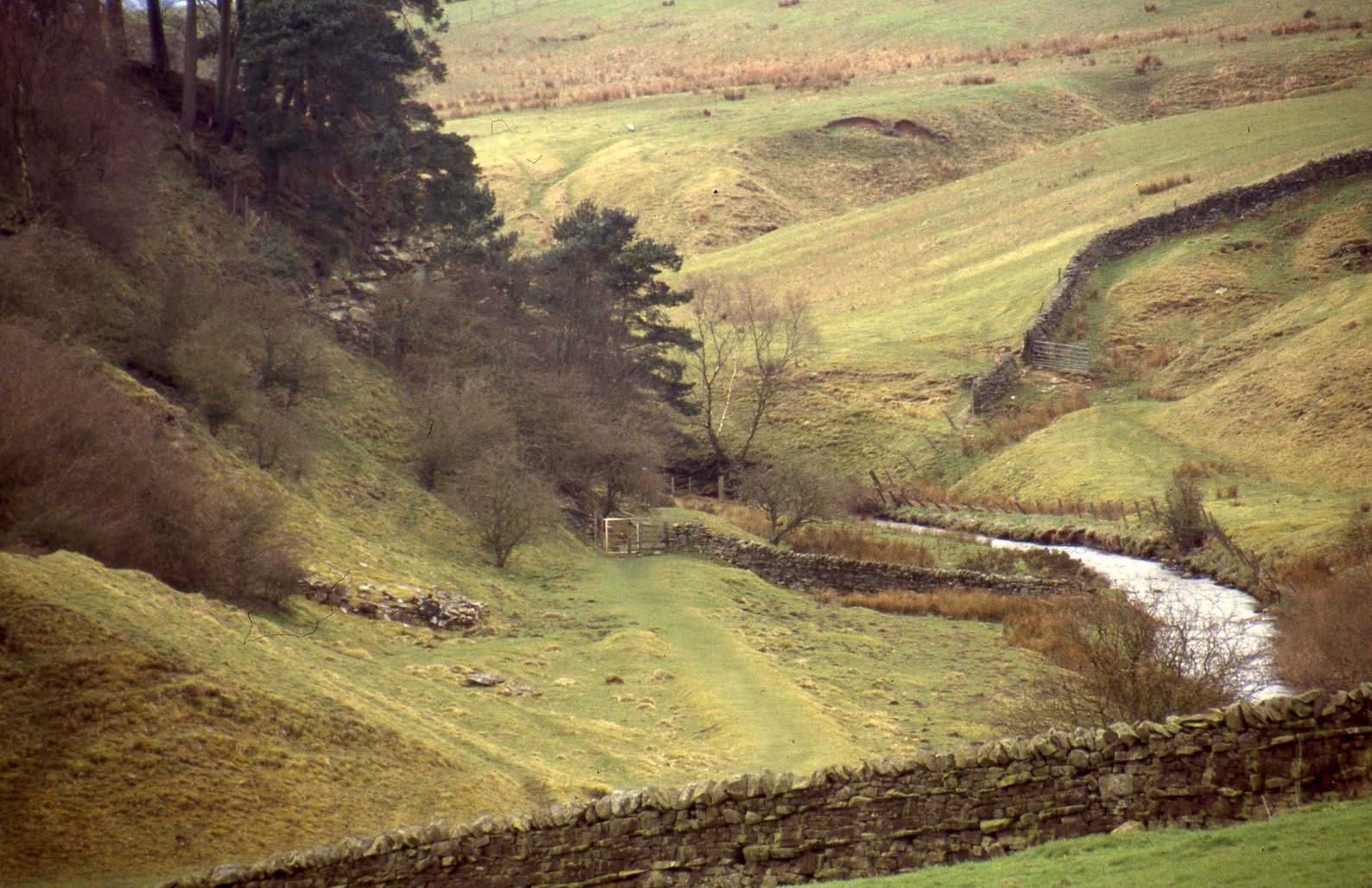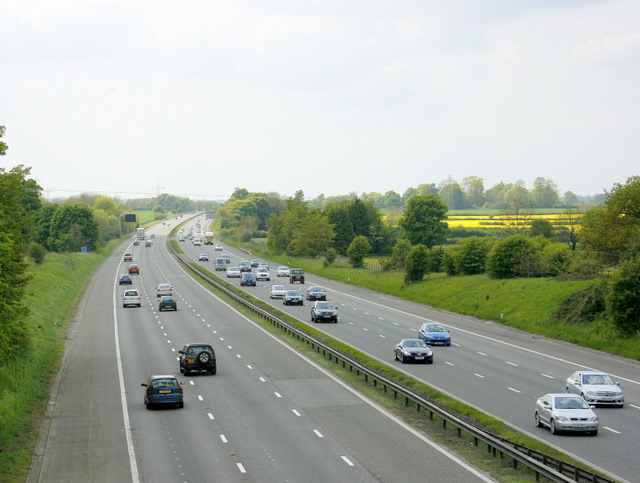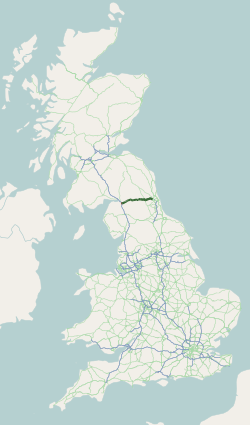|
Haltwhistle A69 Bridge, West
Haltwhistle A69 Bridge, West is a concrete bridge across the River South Tyne at Haltwhistle in Northumberland, England. History The bridge is a concrete arch bridge, which forms part of the Haltwhistle A69 bypass and was completed in 1997. The creation of the bypass allowed the road through Haltwhistle to be detrunked shortly thereafter. As well as carrying the A69 road, the bridge has an additional third lane (separated by a concrete safety barrier) to link adjoining minor roads and carry a footpath. References {{River item box , River = River South Tyne , upstream = Featherstone Bridge , upsub = , downstream = Haltwhistle A69 Bridge, East Haltwhistle A69 Bridge, East is a concrete bridge across the River South Tyne at Haltwhistle in Northumberland, England. History The bridge is a concrete beam bridge, which forms part of the Haltwhistle bypass and was completed in 1994. The crea ... , downsub = {{UK road, A69 , type = road bridge , table ... [...More Info...] [...Related Items...] OR: [Wikipedia] [Google] [Baidu] |
Haltwhistle
Haltwhistle is a market town and civil parish in Northumberland, England, east of Brampton. It had a population of 3,811 at the 2011 Census. Stone-built houses are a feature of Haltwhistle. It is one of two settlements in Great Britain which claim to be the exact geographic centre of the island, along with Dunsop Bridge in Lancashire, to the south. This is the closest community to Hadrian's Wall and to Northumberland National Park, both approximately two miles distant. The name The name Haltwhistle has nothing to do with a railway stop. Early forms of the name are Hautwesel (1240), Hautwysel (1254), Hawtewysill (1279), Hautwysell (1381), Haltwesell (Speede 1610). The second part -twistle relates to two streams or rivers. It derives from two Old English words ''twicce'' or ''twise'', 'twice', 'division into two' and ''wella'', 'stream, brook'. The second word is reduced in the compound word to ''ull'', making ''twicculla'', ''twisella''. All but one of the examples in place na ... [...More Info...] [...Related Items...] OR: [Wikipedia] [Google] [Baidu] |
Bypass (road)
A bypass is a road or highway that avoids or "bypasses" a built-up area, town, or village, to let through traffic flow without interference from local traffic, to reduce congestion in the built-up area, and to improve road safety. A bypass specifically designated for trucks may be called a truck route. If there are no strong land use controls, buildings are often built in town along a bypass, converting it into an ordinary town road, and the bypass may eventually become as congested as the local streets it was intended to avoid. Petrol station A filling station, also known as a gas station () or petrol station (), is a facility that sells fuel and engine lubricants for motor vehicles. The most common fuels sold in the 2010s were gasoline (or petrol) and diesel fuel. Gaso ...s, shopping centres and some other businesses are often built there for ease of access, while homes are often avoided for noise and pollution reasons. Bypass routes are often controversial, ... [...More Info...] [...Related Items...] OR: [Wikipedia] [Google] [Baidu] |
River Tyne
The River Tyne is a river in North East England. Its length (excluding tributaries) is . It is formed by the North Tyne and the South Tyne, which converge at Warden Rock near Hexham in Northumberland at a place dubbed 'The Meeting of the Waters'. The Tyne Rivers Trust measure the whole Tyne catchment as , containing of waterways. Course North Tyne The North Tyne rises on the Scottish border, north of Kielder Water. It flows through Kielder Forest, and in and out of the border. It then passes through the village of Bellingham before reaching Hexham. South Tyne The South Tyne rises on Alston Moor, Cumbria and flows through the towns of Haltwhistle and Haydon Bridge, in a valley often called the Tyne Gap. Hadrian's Wall lies to the north of the Tyne Gap. Coincidentally, the source of the South Tyne is very close to those of the Tees and the Wear. The South Tyne Valley falls within the North Pennines Area of Outstanding Natural Beauty (AONB) – the second largest of the ... [...More Info...] [...Related Items...] OR: [Wikipedia] [Google] [Baidu] |
Northumberland
Northumberland () is a county in Northern England, one of two counties in England which border with Scotland. Notable landmarks in the county include Alnwick Castle, Bamburgh Castle, Hadrian's Wall and Hexham Abbey. It is bordered by land on three sides; by the Scottish Borders region to the north, County Durham and Tyne and Wear to the south, and Cumbria to the west. The fourth side is the North Sea, with a stretch of coastline to the east. A predominantly rural county with a landscape of moorland and farmland, a large area is part of Northumberland National Park. The area has been the site of a number of historic battles with Scotland. Name The name of Northumberland is recorded as ''norð hẏmbra land'' in the Anglo-Saxon Chronicle, meaning "the land north of the Humber". The name of the kingdom of ''Northumbria'' derives from the Old English meaning "the people or province north of the Humber", as opposed to the people south of the Humber Estuary. History ... [...More Info...] [...Related Items...] OR: [Wikipedia] [Google] [Baidu] |
Department For Transport
The Department for Transport (DfT) is a department of His Majesty's Government responsible for the English transport network and a limited number of transport matters in Scotland, Wales and Northern Ireland that have not been devolved. The department is run by the Secretary of State for Transport, currently (since 25 October 2022) Mark Harper. The expenditure, administration and policy of the Department for Transport are scrutinised by the Transport Committee. History The Ministry of Transport was established by the Ministry of Transport Act 1919 which provided for the transfer to the new ministry of powers and duties of any government department in respect of railways, light railways, tramways, canals and inland waterways, roads, bridges and ferries, and vehicles and traffic thereon, harbours, docks and piers. In September 1919, all the powers of the Road Board, the Ministry of Health, and the Board of Trade in respect of transport, were transferred to the new ministry. ... [...More Info...] [...Related Items...] OR: [Wikipedia] [Google] [Baidu] |
National Highways
National Highways, formerly the Highways Agency and later Highways England, is a State-owned enterprise, government-owned company charged with operating, maintaining and improving Roads in England, motorways and major A roads in England. It also sets highways standards used by all four UK administrations, through the Design Manual for Roads and Bridges. Within England, it operates information services through the provision of on-road signage and its Traffic England website, provides National Highways traffic officer, traffic officers to deal with incidents on its network, and manages the delivery of improvement schemes to the network. Founded as an executive agency, it was converted into a government-owned company, Highways England, on 1 April 2015. As part of this transition, the Government of the United Kingdom, UK government set out its vision for the future of the English strategic road network in its Road Investment Strategy. A second Road Investment Strategy was published ... [...More Info...] [...Related Items...] OR: [Wikipedia] [Google] [Baidu] |
Arch Bridge
An arch bridge is a bridge with abutments at each end shaped as a curved arch. Arch bridges work by transferring the weight of the bridge and its loads partially into a horizontal thrust restrained by the abutments at either side. A viaduct (a long bridge) may be made from a series of arches, although other more economical structures are typically used today. History Possibly the oldest existing arch bridge is the Mycenaean Arkadiko Bridge in Greece from about 1300 BC. The stone corbel arch bridge is still used by the local populace. The well-preserved Hellenistic Eleutherna Bridge has a triangular corbel arch. The 4th century BC Rhodes Footbridge rests on an early voussoir arch. Although true arches were already known by the Etruscans and ancient Greeks, the Romans were – as with the vault and the dome – the first to fully realize the potential of arches for bridge construction. A list of Roman bridges compiled by the engineer Colin O'Connor featur ... [...More Info...] [...Related Items...] OR: [Wikipedia] [Google] [Baidu] |
Concrete
Concrete is a composite material composed of fine and coarse aggregate bonded together with a fluid cement (cement paste) that hardens (cures) over time. Concrete is the second-most-used substance in the world after water, and is the most widely used building material. Its usage worldwide, ton for ton, is twice that of steel, wood, plastics, and aluminum combined. Globally, the ready-mix concrete industry, the largest segment of the concrete market, is projected to exceed $600 billion in revenue by 2025. This widespread use results in a number of environmental impacts. Most notably, the production process for cement produces large volumes of greenhouse gas emissions, leading to net 8% of global emissions. Other environmental concerns include widespread illegal sand mining, impacts on the surrounding environment such as increased surface runoff or urban heat island effect, and potential public health implications from toxic ingredients. Significant research and development is ... [...More Info...] [...Related Items...] OR: [Wikipedia] [Google] [Baidu] |
River South Tyne
The River Tyne is a river in North East England. Its length (excluding tributaries) is . It is formed by the North Tyne and the South Tyne, which converge at Warden Rock near Hexham in Northumberland at a place dubbed 'The Meeting of the Waters'. The Tyne Rivers Trust measure the whole Tyne catchment as , containing of waterways. Course North Tyne The North Tyne rises on the Scottish border, north of Kielder Water. It flows through Kielder Forest, and in and out of the border. It then passes through the village of Bellingham before reaching Hexham. South Tyne The South Tyne rises on Alston Moor, Cumbria and flows through the towns of Haltwhistle and Haydon Bridge, in a valley often called the Tyne Gap. Hadrian's Wall lies to the north of the Tyne Gap. Coincidentally, the source of the South Tyne is very close to those of the Tees and the Wear. The South Tyne Valley falls within the North Pennines Area of Outstanding Natural Beauty (AONB) – the second largest of th ... [...More Info...] [...Related Items...] OR: [Wikipedia] [Google] [Baidu] |
A69 Road
The A69 is a major northern trunk road in England, running east–west across the Pennines, through the counties of Tyne and Wear, Northumberland and Cumbria. Originally, the road started in the centre of Newcastle upon Tyne then later near Birtley, but since the creation of the A1 road (Great Britain), A1 Western Bypass around Newcastle upon Tyne, it now starts at Denton Burn, a suburb of Newcastle upon Tyne. The route from the A1 junction to Carlisle city centre is 54 miles (87 km). Settlements on the route * Denton Burn * West Denton * Throckley * (Corbridge) * (Hexham) * (Haydon Bridge) * Bardon Mill * Melkridge * (Haltwhistle) * (Brampton, Carlisle, Brampton) * Warwick Bridge * Warwick-on-Eden * Botcherby * Carlisle Places with parentheses are indicative of historically being on the A69, but have now been bypassed Description of the route The road runs westwards from the A1 at Denton Burn in Newcastle upon Tyne through the suburbs of Denton Burn and West Denton be ... [...More Info...] [...Related Items...] OR: [Wikipedia] [Google] [Baidu] |
Featherstone Bridge
Featherstone Bridge is a stone arch bridge across the River South Tyne at Featherstone in Northumberland. History This structure is a stone arch bridge completed in 1775. It is a Grade II* listed structure. There is a plaque above the keystone on inner face of the west parapet displaying the name of the bridge. References {{River item box , River = River South Tyne The River Tyne is a river in North East England. Its length (excluding tributaries) is . It is formed by the North Tyne and the South Tyne, which converge at Warden Rock near Hexham in Northumberland at a place dubbed 'The Meeting of the Wat ... , upstream = Diamond Oak Bridge , upsub = Road and {{UK NCN route, route=68 , downstream = Haltwhistle A69 Bridge, West , downsub = {{UK road, A69 , type = road bridge , table = end , location = NY675619 Bridges in Northumberland Crossings of the River Tyne Grade II* listed buildings in Northumberland ... [...More Info...] [...Related Items...] OR: [Wikipedia] [Google] [Baidu] |
Bellister Bridge
Bellister Bridge is a concrete bridge across the River South Tyne at Haltwhistle in Northumberland, England. History The bridge, which was designed to provide road access to the village of Plenmeller on the south bank of the river, was completed in 1967. After the Haltwhistle bypass opened, the road was no longer required and it has solely been used a footbridge since the late 1990s. The bridge also provides access to Bellister Castle Bellister Castle is a National Trust owned castellated 19th-century mansion house attached to the ruinous remains of a 14th-century tower house, near Haltwhistle, Northumberland, England. It is a Scheduled Ancient Monument and a Grade I listed ... on the south bank of the river. References {{Authority control Bridges in Northumberland Crossings of the River Tyne Haltwhistle ... [...More Info...] [...Related Items...] OR: [Wikipedia] [Google] [Baidu] |






